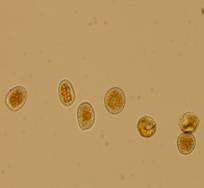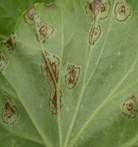Rust Diseases of Ornamental Crops
Introduction
Rust diseases are common fungal infections that affect a wide range of floricultural crops, including Aster, Carnation, Fuchsia, Florist's geranium (Pelargonium X hortorum ) Gladiolus, Lilium, Marigold, Poinsettia, Snapdragons, Statice and Viola (including pansy). Rusts have the potential to negatively impact floriculture production because these pathogens often cannot be detected on infected, but symptomless propagation material entering the United States or moving state-to-state. Rust fungi are obligate parasites, dependent upon a live host for growth and development, and seldom kill plants. However, rust infection reduces plant health and vigor, flower production, and aesthetic value.
Symptoms
Each type of Rust has its own distinctive symptoms and its own specific plant hosts. The disease often first appears as chlorosis on the upper surfaces of leaves. All rust fungi produce powdery masses of spores in pustules, typically on leaf undersides that are yellow, orange, purple, black or brown. Some Rust fungi produce pustules on upper leaf surfaces as well. Spores are easily spread on air or with splashing water. Lesions may coalesce resulting in large areas of necrosis; leaf distortion and defoliation often follow.
Life History

Many Rusts have complex life cycles that include up to five different spore stages at different times of the year and two or more distinctly different hosts. Other Rusts produce only one type of spore or occur in all spore stages on one kind of plant. Fuchsia Rust requires both fir and fireweed to complete its life cycle. Rose Rust produces four spore stages, but only roses are affected. Urediospores ("repeating spores") are produced in yellow, orange, or brown pustules during the summer and spread the disease rapidly. Rusts usually spend the winter as teliospores, which require a dormant period before germination. In the spring, basidiospores are produced from germinating teliospores and start the initial infection. One infection is established, aeciospores are produced, often upon alternate hosts, in cup-shaped bodies that are easily seen. The aeciospores cannot reinfect the host upon which they are produced, only the alternate host, which produces the repeating spores (urediospores) Some Rusts overwinter as mycelium within the tissue of infected perennial plants.
Aster Rust
Aster is affected by several rust diseases- Coleosporium campanulae, Puccinia asteris, P. campanulae, and other Puccinia species. Orange-red pustules develop on the leaf undersides; heavy infections can cause leaf yellowing and necrosis. C. campanulae requires pine as an alternate host, while Puccinia species have various sedges and grasses as alternate hosts. The removal of alternate hosts is a good management strategy. Photo
Carnation Rust
Caused by Uromyces diantha, this rust disease is characterized by small pustules of powdery, brown urediospores. These spores are carried over only on live plants. Resistant cultivars are available.
Chrysanthemum Rust
Two species of Puccinia causes rust on chrysanthemums P . chrysanthemi and P. horiana. P. chrysanthemi is most common in late summer and is characterized by dirty-brown pustules and yellowish-green spots on upper surfaces of leaves. P. chrysanthemi causes minor damage in the field and is uncommon on greenhouse plants. Severe infestation may damage large areas of leaves and lead to defoliation and reduced flower production. Chrysanthemum varieties resistant to rust include 'Achievement', 'Copper Bowl', 'Escapade', 'Helen Castle', ' Mandalay ', 'Matador', 'Miss Atlanta', 'Orange Bowl', and 'Powder Puff'. P. horiana causes Chrysanthemum white rust and as a recent introduction to the United States is subject to quarantine and an eradication program. Symptoms are white, pinkish or brownish pustules produced on leaf undersides with white, yellow, to pale-green lesions on upper leaf surfaces. Chrysanthemum white rust results in leaf distortion, discoloration, defoliation, and plant death. White rust is primarily a disease of greenhouse crops; when it occurs outside direct sunlight and low humidity kill the spores. Contact state and federal agricultural officials if any suspect white rust infections occur and destroy all plants. Regulations require that infect plants be destroyed to prevent disease establishment in this country. (See Chrysanthemum White Rust Fact Sheet). Photo: Chrysanthemum White Rust
Fuchsia Rust

Fuchsia rust is caused by the fungus Pucciniastrum epilobii and occurs throughout the United States. The most serious losses occur during propagation; diseased plants at any stage are not marketable. Affected leaves may be deformed and defoliation often occurs. Weakened plants may occasionally die. The initial source of spores may be from the alternate hosts, fir or fireweed, especially if plants are kept outside in the summer, or from infected stock brought in from other sources. Photo
Geranium Rust

Geranium rust caused by Puccinia pelargoni-zonalis is most serious on Florist's geraniums (Pelargonium X hortorum), but has also been reported on zonal geraniums and seedling geraniums. Ivy geranium (P. peltatum), Martha Washington or regal (P. X domesticum), the scented leaf types, and the wild geraniums are resistant. Geranium rust occurs throughout the United States due to the ease with which it is spread on infected cuttings. This rust spends its entire life cycle on geranium (autoecious). Symptoms first appear as small, circular, yellow spots on the top of leaves opposite the pustules on the lower leaf surface. The spots on the lower leaves enlarge to blister-like pustules of rust to cinnamon brown spores which often develop in concentric rings. The purchase of certified, culture-indexed cuttings from a reputable commercial propagator is an important means of disease control. Photo
Poinsettia Rust
Unlike most other rust fungi, pustules of Poinsettia Rust caused by Uromyces euphorbiae occur on both leaf surfaces. Spores are cinnamon brown and occur only on living plants.
Rose (Rosa species) Rust

Rose rust caused by Phragimidium mucronatum first appears in the spring as bright orange pustules on leaf undersides, leaf stalks and branches. In the summer, small raised orange spots appear on the undersides of leaves with small yellow specks on the upper surface beginning on the lower leaves and moving upward. The spots may go unnoticed until the plant begins to exhibit a generally unhealthy appearance and a loss of the lower leaves. Leaves may become dry and twisted before falling off. As the leaves dies, the spots darken and produce the black teliospores that survive the winter to produce new infections in the spring. This disease may be mild or severe depending on the season and how early the infection began. Prune and burn infected leaves, petals, and canes as soon as they are detected. Cultivars vary in their susceptibility to rust diseases.
Viola species Rust
Caused by Puccinia viola, this rust disease is common in the Northeast. Symptoms first appear as small, pale green spots on the upper leaf surface. As the fungus develops within the leaf, corky spots, blisters, or pustules containing rusty brown spores develop on leaf undersides.
Management of Rust Diseases
- Purchase only disease free plants or cuttings. Carefully inspect all incoming plant shipments for rust symptoms.
- Keep new plants isolated from established plants for up to three weeks to allow rust diseases to develop, if present.
- Scout regularly for rust diseases.
- Frequently remove all rust-infected leaves and badly infected plants and destroy by burning, rapid composting, or burying
- At the end of the growing season, carefully clean up and destroy all crop debris. Sterilize benches and propagation rooms with an appropriate greenhouse disinfectant.
- Keep the humidity within the greenhouse at less than 80%. Increasing air movement by adding fans will prevent moisture from condensing on the foliage.
- Practice only surface watering and avoid splashing water onto foliage. If overhead irrigation is necessary, water in the early morning when plants will dry quickly.
- Space plants to allow for good air circulation.
- In the case of outside varieties, such as rose or Violas, in the fall, carefully clean-up and all leaf litter and destroy. Severely infected roses can be dramatically pruned.
- A combination of cultural and chemical control is often required to control rust diseases. There are many effective rust products and these should be applied on a protective basis according to label instructions. Be sure to rotate applications between chemical classes to prevent fungicide resistance from developing.
| Fungicide | Chemical Class (FRAC code) | Results* |
|---|---|---|
| Banner Maxx | Sterol Inhibitor (3) | Good to excellent |
| Cleary's 3336 50 WP | Methyl benzimidiazole (1) | Good |
| Compass 50W | Strobilurin (11) | Poor to excellent |
| Cygnus | Strobilurin (11) | Some to excellent |
| Daconil Weather Stik | Chloronitriles (M5) | Some |
| Decree 50W | Hydroxyanilide (17) | Some |
| Eagle 20EW | Sterol inhibitor (3) | Excellent |
| Heritage 50WDG | Strobilurin (11) | Very good to excellent |
| Phyton 27 | Copper (M3) | Good to excellent |
| Spectro 90 WDG | Methyl benzimidizoles plus chloronitriles (1plus M5) | Good |
| Stature | Carbamate (40) | Excellent |
| Strike 25WP | Sterol inhibitor (3) | Excellent |
| Systhane 40WP | Sterol inhibitor (3) | Excellent |
| Terraguard 50W | Sterol inhibitor (3) | Poor to very good |
* From A.R. Chase. Chase Research Gardens, Inc.
References
- New England Greenhouse Floriculture Guide
- Wick, Robert. Fuchsia Rust.
Revised 12/2013
